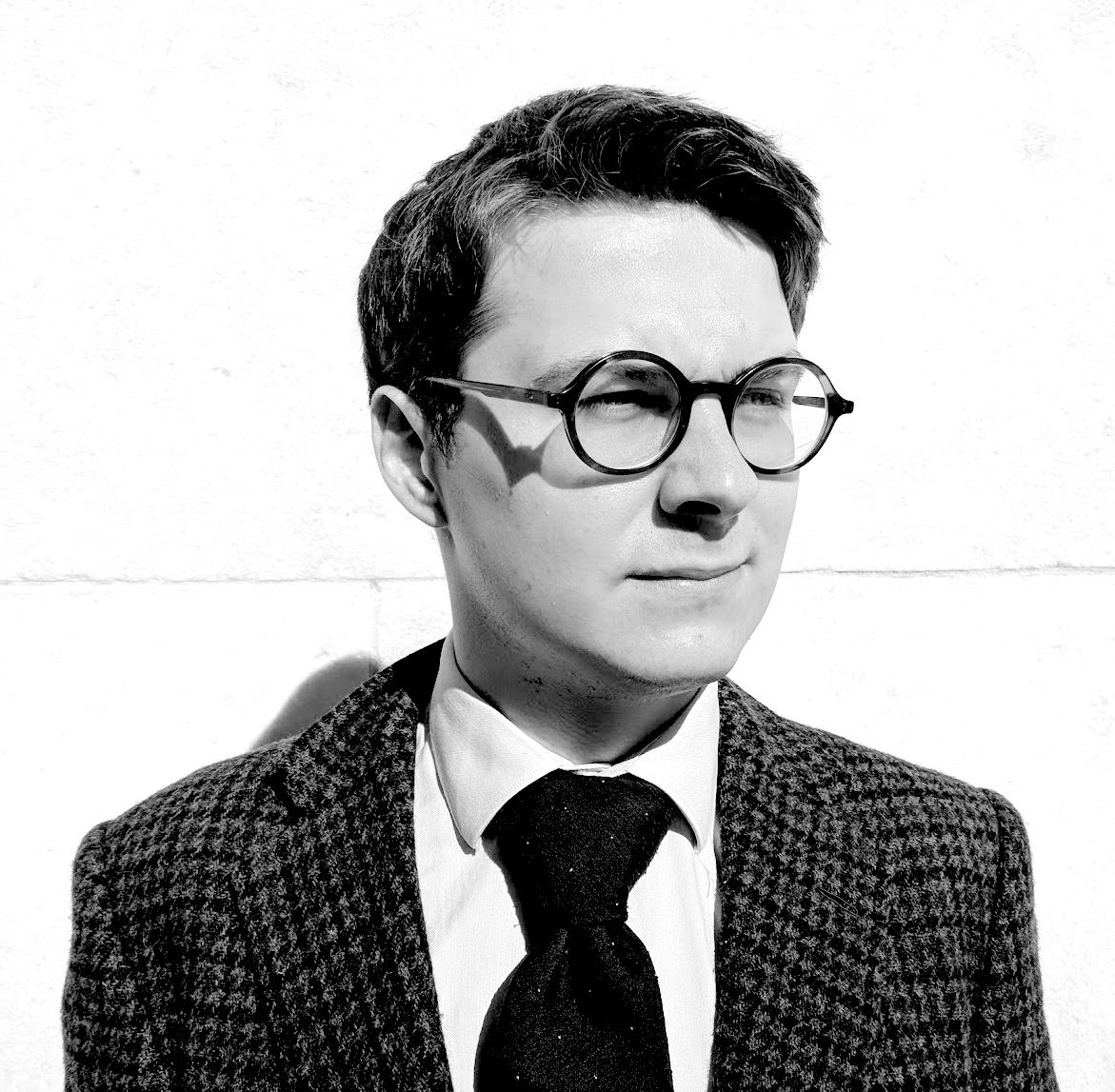Journal paper
Publication Types:
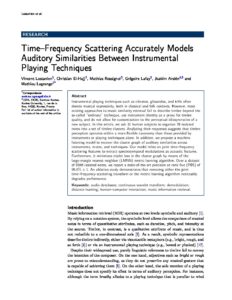
Time–frequency scattering accurately models auditory similarities between instrumental playing techniques
Instrumental playing techniques such as vibratos, glissandos, and trills often denote musical expressivity, both in classical and folk contexts. However, most existing approaches to music similarity retrieval fail to describe timbre beyond the so-called “ordinary” technique, use instrument identity as a proxy for timbre quality, and do not allow for customization to the perceptual idiosyncrasies of a new subject. In this article, we ask 31 human participants to organize 78 isolated notes into a set of timbre clusters. Analyzing their responses suggests that timbre perception operates within a more flexible taxonomy than those provided by instruments or playing techniques alone. In addition, we propose a machine listening model to recover the cluster graph of auditory similarities across instruments, mutes, and techniques. Our model relies on joint time–frequency scattering features to extract spectrotemporal modulations as acoustic features. Furthermore, it minimizes triplet loss in the cluster graph by means of the large-margin nearest neighbor (LMNN) metric learning algorithm. Over a dataset of 9346 isolated notes, we report a state-of-the-art average precision at rank five (AP@5) of 99.0%±1. An ablation study demonstrates that removing either the joint time–frequency scattering transform or the metric learning algorithm noticeably degrades performance.
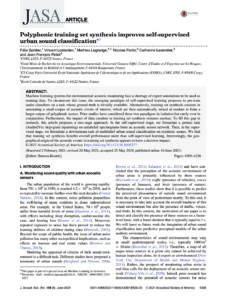
Polyphonic training set synthesis improves self-supervised urban sound classification
Machine listening systems for environmental acoustic monitoring face a shortage of expert annotations to be used as training data. To circumvent this issue, the emerging paradigm of self-supervised learning proposes to pre-train audio classifiers on a task whose ground truth is trivially available. Alternatively, training set synthesis consists in annotating a small corpus of acoustic events of interest which are then automatically mixed at random to form a larger corpus of polyphonic scenes. Prior studies have considered these two paradigms in isolation, but rarely ever in conjunction. Furthermore, the impact of data curation in training set synthesis remains unclear. To fill this gap in research, this article proposes a two-stage approach. In the self-supervised stage, we formulate a pretext task (Audio2Vec skip-gram inpainting) on unlabeled spectrograms from an acoustic sensor network. Then, in the supervised stage, we formulate a downstream task of multilabel urban sound classification on synthetic scenes. We find that training set synthesis benefits more to overall performance than self-supervised learning. Interestingly, the geographical origin of the acoustic events in training set synthesis appears to have a decisive impact.
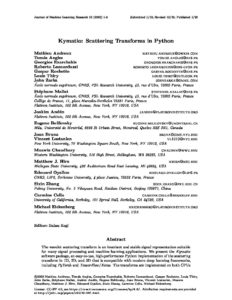
Kymatio: Scattering transforms in Python
The wavelet scattering transform is an invariant and stable signal representation suitable for many signal processing and machine learning applications. We present the Kymatio software package, an easy-to-use, high-performance Python implementation of the scattering transform in 1D, 2D, and 3D that is compatible with modern deep learning frameworks, including PyTorch and TensorFlow/Keras. The transforms are implemented on both CPUs and GPUs, the latter offering a significant speedup over the former. The package also has a small memory footprint. Source code, documentation, and examples are available under a BSD license at https://www.kymat.io.
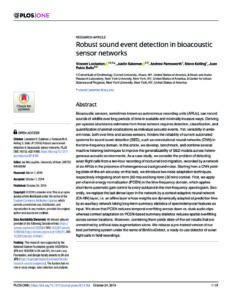
Robust sound event detection in bioacoustic sensor networks
Bioacoustic sensors, sometimes known as autonomous recording units (ARUs), can record sounds of wildlife over long periods of time in scalable and minimally invasive ways. Deriving per-species abundance estimates from these sensors requires detection, classification, and quantification of animal vocalizations as individual acoustic events. Yet, variability in ambient noise, both over time and across sensors, hinders the reliability of current automated systems for sound event detection (SED), such as convolutional neural networks (CNN) in the time-frequency domain. In this article, we develop, benchmark, and combine several machine listening techniques to improve the generalizability of SED models across heterogeneous acoustic environments. As a case study, we consider the problem of detecting avian flight calls from a ten-hour recording of nocturnal bird migration, recorded by a network of six ARUs in the presence of heterogeneous background noise. Starting from a CNN yielding state-of-the-art accuracy on this task, we introduce two noise adaptation techniques, respectively integrating short-term (60 milliseconds) and long-term (30 minutes) context. First, we apply per-channel energy normalization (PCEN) in the time-frequency domain, which applies short-term automatic gain control to every subband in the mel-frequency spectrogram. Secondly, we replace the last dense layer in the network by a context-adaptive neural network (CA-NN) layer. Combining them yields state-of-the-art results that are unmatched by artificial data augmentation alone. We release a pre-trained version of our best performing system under the name of BirdVoxDetect, a ready-to-use detector of avian flight calls in field recordings.
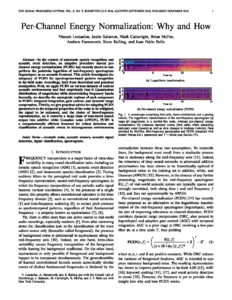
Per-channel energy normalization: Why and how
In the context of automatic speech recognition and acoustic event detection, an adaptive procedure named per-channel energy normalization (PCEN) has recently shown to outperform the pointwise logarithm of mel-frequency spectrogram (logmelspec) as an acoustic frontend. This letter investigates the adequacy of PCEN for spectrogram-based pattern recognition in far-field noisy recordings, both from theoretical and practical standpoints. First, we apply PCEN on various datasets of natural acoustic environments and find empirically that it Gaussianizes distributions of magnitudes while decorrelating frequency bands. Second, we describe the asymptotic regimes of each component in PCEN: temporal integration, gain control, and dynamic range compression. Third, we give practical advice for adapting PCEN parameters to the temporal properties of the noise to be mitigated, the signal to be enhanced, and the choice of time-frequency representation. As it converts a large class of real-world soundscapes into additive white Gaussian noise, PCEN is a computationally efficient frontend for robust detection and classification of acoustic events in heterogeneous environments.
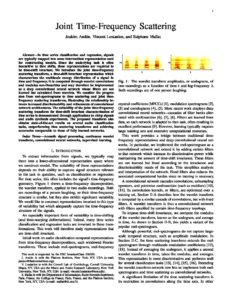
Joint time–frequency scattering
In time series classification and regression, signals are typically mapped into some intermediate representation used for constructing models. Since the underlying task is often insensitive to time shifts, these representations are required to be time-shift invariant. We introduce the joint time-frequency scattering transform, a time-shift invariant representation that characterizes the multiscale energy distribution of a signal in time and frequency. It is computed through wavelet convolutions and modulus non-linearities and may, therefore, be implemented as a deep convolutional neural network whose filters are not learned but calculated from wavelets. We consider the progression from mel-spectrograms to time scattering and joint time-frequency scattering transforms, illustrating the relationship between increased discriminability and refinements of convolutional network architectures. The suitability of the joint time-frequency scattering transform for time-shift invariant characterization of time series is demonstrated through applications to chirp signals and audio synthesis experiments. The proposed transform also obtains state-of-the-art results on several audio classification tasks, outperforming time scattering transforms and achieving accuracies comparable to those of fully learned networks.
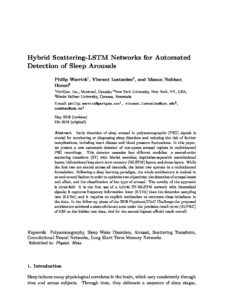
Hybrid scattering-LSTM networks for automated detection of sleep arousals
Early detection of sleep arousal in polysomnographic (PSG) signals is crucial for monitoring or diagnosing sleep disorders and reducing the risk of further complications, including heart disease and blood pressure fluctuations. Approach: In this paper, we present a new automatic detector of non-apnea arousal regions in multichannel PSG recordings. This detector cascades four different modules: a second-order scattering transform (ST) with Morlet wavelets; depthwise-separable convolutional layers; bidirectional long short-term memory (BiLSTM) layers; and dense layers. While the first two are shared across all channels, the latter two operate in a multichannel formulation. Following a deep learning paradigm, the whole architecture is trained in an end-to-end fashion in order to optimize two objectives: the detection of arousal onset and offset, and the classification of the type of arousal. Main results and Significance: The novelty of the approach is three-fold: it is the first use of a hybrid ST-BiLSTM network with biomedical signals; it captures frequency information lower (0.1 Hz) than the detection sampling rate (0.5 Hz); and it requires no explicit mechanism to overcome class imbalance in the data. In the follow-up phase of the 2018 PhysioNet/CinC Challenge the proposed architecture achieved a state-of-the-art area under the precision-recall curve (AUPRC) of 0.50 on the hidden test data, tied for the second-highest official result overall.
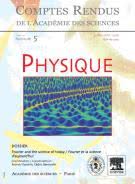
Fourier at the heart of computer music: From harmonic sounds to texture
Beyond the scope of thermal conduction, Joseph Fourier’s treatise on the Analytical Theory of Heat (1822) profoundly altered our understanding of acoustic waves. It posits that any function of unit period can be decomposed into a sum of sinusoids, whose respective contributions represent some essential property of the underlying periodic phenomenon. In acoustics, such a decomposition reveals the resonant modes of a freely vibrating string. The introduction of Fourier series thus opened new research avenues on the modeling of musical timbre—a topic that was to become of crucial importance in the 1960s with the advent of computer-generated sounds. This article proposes to revisit the scientific legacy of Joseph Fourier through the lens of computer music research. We first discuss how the Fourier series marked a paradigm shift in our understanding of acoustics, supplanting the theory of consonance of harmonics in the Pythagorean monochord. Then, we highlight the utility of Fourier’s paradigm via three practical problems in analysis–synthesis: the imitation of musical instruments, frequency transposition, and the generation of audio textures. Interestingly, each of these problems involves a different perspective on time–frequency duality, and stimulates a multidisciplinary interplay between research and creation that is still ongoing.
